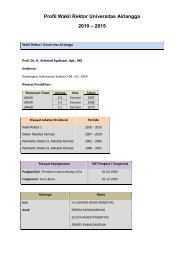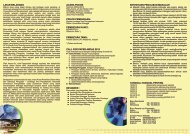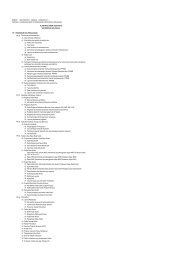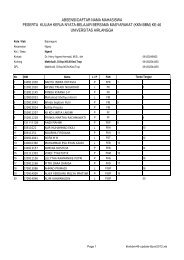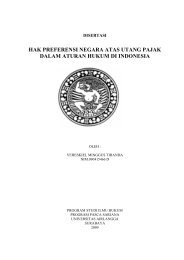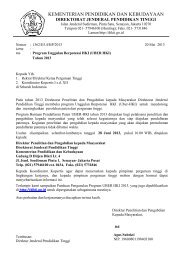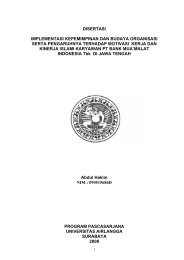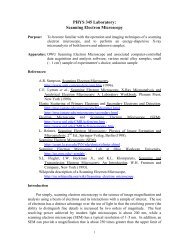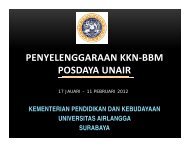View - UNAIR | E-Book Collection
View - UNAIR | E-Book Collection
View - UNAIR | E-Book Collection
You also want an ePaper? Increase the reach of your titles
YUMPU automatically turns print PDFs into web optimized ePapers that Google loves.
TERENCE URNERFig. 6. Kayapo chiefs signletters at a meeting at theFUNAI office in Colider,Mato Grosso, on 26 July2006. Front left to right:Kokoreti of Mekranoti,Ropni of Mentuktire, andMegaron Txukarramãe,regional FUNAI director.One letter was to PresidentLula, protesting against theillegality of his government’sattempt to circumventBrazilian laws in goingahead with the road pavingproject without the requiredenvironmental impactevaluation; another was tothe World Bank, urging it notto lend money to support theillegal project.Transport to proceed with plans for the paving of BR-163. This was irregular, since the Environmental ImpactAssessment normally required for such a licence had notyet been completed. The delay had been caused by disagreementsbetween the Ministry of the Environment andits agency, IBAMA, and the Ministry of Transport over theterms of the EIA.After six months the dispute was finally ‘solved’ bythe Minister of the Environment, Marina Silva, who inearly June produced a new ‘Plan for a sustainable BR-163’ designed to substitute for the legally required EIAand thus allow the licence granted six months earlier tobe activated (MS 06/06/06; 29/06/06). The plan containedprovisions for protected forest zones beside the road buttook no account of the proposals by the Kayapo for thedemarcation and police protection of indigenous communitieslocated near the road.This bureaucratic manoeuvre was completed withoutconsulting the Kayapo or any of the other indigenousor regional groups who had faithfully attended the hearingsfor the EIA and contributed their critical inputs (MS06/06/06). The result was triumphantly announced byLula in a speech on 6 June, followed a month later by ashort report in the official Gazette of Mato Grosso that thelicence had been issued and paving would proceed withoutreference to the legally required EIA (AA 22/12/05; MS06/06/06, 12/06/06; A Gazeta de Cuiaba 2006).The (paved) road shall not pass!When this came to the notice of the Kayapo, they werefurious. They felt that they had been betrayed by the government’shearings for the EIA, which they now saw ashaving been a ruse to distract them while the governmentsecretly went ahead with its plans to proceed with theproject without regard for the environmental and socialprotections, to say nothing of the consultations with themand other indigenous groups of the area, required by itsown laws. Kayapo and Panara leaders from the Xingúvalley met in the second week of July and agreed to takeimmediate action. They wrote to Lula denouncing his government’sviolation of Brazilian law and human rights, andto the president of the World Bank urging him not to granta loan for the road-paving project. A third letter went to theAttorney General of Brazil, calling upon him to enforcethe law and vowing to prevent the road from being paveduntil the government decided to comply with its own lawscovering licensing and EIAs.Then, making good on their promise, they sent a partyto blockade BR-163. For good measure, they also cut BR-80, the federal highway that serves as their boundary withthe National Park of the Xingú to the south, by sequesteringthe ferry that carries road traffic across the Xingú.They maintained the closure of both roads for four days,from 22 to 26 July, which was how long it took the federalgovernment and the state government of Mato Grossoto agree to the Kayapo’s condition for calling off theblockade. This was to send high-level representatives toa meeting with Kayapo leaders to discuss the restitutionof the environmental and social protections demanded bythe Kayapo and others in the public hearings for the EIA(Megaron Txukarramãe, personal communication; MS25-27/07/06).The meeting was held on 26 July at the Kayapo-controlledFUNAI headquarters in Colider, Mato Grosso. After sittingthrough a day of harangues by Kayapo leaders interspersedwith periodic eruptions of chanting and dancing byabout 100 or so Kayapo and Indians from other groups thathad participated in the roadblock alongside the Kayapo,the government representatives promised to produce arevised version of the road paving project incorporatingthe Kayapo demands within 30 days. This was the graceperiod granted by the Kayapo before the blockade of theroads would be renewed if no response were forthcoming(Sue Cunningham, personal communication). ANTHROPOLOGY TODAY Vol 22 No 5, October 2006



